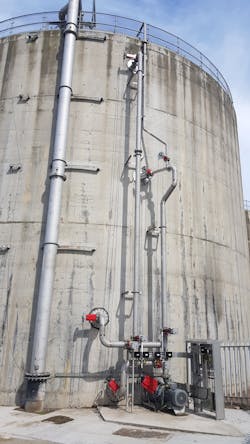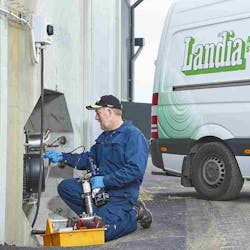About the author:
Chris French is a freelance writer on water, environment and renewable energy issues. French can be reached at [email protected].
Just over a year ago, UK-based Thames Water went out to bid with lots worth close to $100 million covering biogas and biomethane. The United Kingdom’s largest water utility has 25 sites using anaerobic digestion (AD) biogas processes, which produce a total of more than 800 GWh/year of electricity from biogas.
The drive in the UK and Europe to achieve net-zero carbon emissions to mitigate climate change is in full swing with no turning back. But in the U.S., although there is now noticeable momentum from the new government, there simply are not the same drivers for water resource recovery facilities to invest heavily in new AD or biogas equipment.
Money talks of course, so when UK water companies were privatized in 1989, thus ensued a relentless need to please shareholders with the biggest possible profit. As such, there has been no shortage of enthusiasm to transform all of that methane-rich sludge into clean, green, lucrative renewable energy.
According to the American Biogas Council, there are 1,269 water resource recovery facilities in the U.S. using an anaerobic digester, with potential for a further 3,878, including 380 that are making biogas but are not using it, which is bound to be met with a sigh of frustration by those who have declared ‘a climate emergency’ as they see useful gas being flared off into oblivion.
So long as the cost of a kilowatt hour for businesses in the U.S. remains as low as around 6 to 8 cents, then the investment into biogas plants is going to remain gradual. It would surely be a different story altogether if the price was 15 to 20 cents per kWh.
In Europe’s water industry alone, countries such as the UK, Germany and Scandinavia have made huge inroads into AD/Biogas production, for practical, money-making or net-zero carbon reasons.
Increase in AD/Biogas Inquiries
But the U.S. is not standing still, with an increasing number of sewage treatment plants now focusing on renewable energy, self-sufficiency, reducing their carbon footprint and energy usage. New regulations will also come into force in California in 2022 for local governments and businesses to be required to compost, anaerobically digest, or otherwise recycle food scraps, yard trimmings and other organic waste, rather than see it sent to landfill.
“During the past 12 to 18 months, we’ve certainly seen an increase in AD/Biogas inquiries,” said Soren Rasmussen, director of mixer and pump manufacturer, Landia, based in Cary, North Carolina. “Many of the old-style mixing systems, which are actually very inefficient, are coming to their end of their time, so it is heartening to see water treatment plants now wanting to upgrade to a far superior and easier to manage mixing system.”
Rasmussen said that old compressor and gas injection systems — as well as top-mounted propellers — have, over the years, helped produce some gas, but on the whole, digesters have not been mixed comprehensively and typically under-perform because of such a large amount of grit that has accumulated from the solids and grit that reduce the vessel’s working capacity.
One would not buy a car with five gears, but only ever use gears one and two, so Rasmussen has a point. Biogas yields are important of course, but as Landia found with its digester mixing system installation at Downers Grove Sanitary District, the benefits of new equipment – very much designed for purpose – are many-fold. At this Illinois Wastewater Treatment Center, there has been lengthy, ongoing issues with a compressor on the gas recirculating mixing system in Primary Digester No. 1, which has a 55-foot-diameter and a liquid volume of 460,000 gallons.
The upgrade to Landia’s mixing system, which includes the Chopper Pump that Landia invented in 1950, consisted of straightforward core-drilling through the tank wall, so the angled solid stainless-steel nozzles could be positioned for optimum mixing.
In phase one of the mixing process, the Landia chopper pump draws material from the digester. Chopping is then completed before the reduced particles are pumped through an aspirating venturi chamber. The resulting vacuum draws biogas down from the digester head space and injects it into the liquid, mixing the solids vertically. This also prevents any layer of scum or crust from forming on the surface, which is a common problem at AD and biogas plants all over the world.
Highest Possible Volume of Active Digestion
In phase two, a high-pressure mixing nozzle injects liquid into the lower half of the digester, creating a rotational horizontal mixing pattern that keeps solids from settling. The mixing system ensures the highest possible volume of active digestion and makes the digester operate more efficiently.
Top of Form
The flow distribution to each nozzle is controlled by actuated valves, and each valve’s operation time is determined by the sludge characteristics, which can be fine-tuned to provide effective mixing with the lowest possible parasitic load.
Overall, there has been a 20% increase in digester gas production at Downers Grove Sanitary District, and the destruction of volatile solids has increased from around 54% to approximately 65%.
But as impressive as these vastly improved figures are, Soren Rasmussen from Landia says that even though the private ownership drive for profits a la Thames Water does not apply to the municipalities in the U.S., there is still plenty of incentive from treatment plant operators to enjoy a wide range of benefits from upgrading mixers.
“In addition to boosting the amount of biogas, big savings can also be made on labour and maintenance,” he said, “because there is really no need to have a mixing system on a digester with wearing parts trapped on the inside of the tank. With externally-mounted equipment, operators can see and hear what is going on. And when servicing is required, everything is easy to get at on the outside of the digester [and] in the worst-case scenario, none of the drama of having to stop the whole process and drain a tank to carry out repairs.”
Energy Neutrality on the Agenda
“A well-designed mixing set-up is also far safer for operators, because unlike many systems, there is no need to work in the gas zone, and no need to work at height.” Rasmussen said. “No matter how careful you are, working at height, especially outdoors in winter or in strong winds, is not brilliant. There’s also energy-usage of the mixers. Some of the old units would have to run 24/7, but as there continues to be more and more interest in greener solutions, especially from the younger generation of engineers, they will look closely at costs, so a mixing system that might only need to run for 10 to 20 minutes per hour is far preferable.”
Rasmussen said in a recent Landia installation, mixers reduced the treatment plant’s energy bill by $18,000 pa. Saving energy expenses like this, he said, can be huge for a utility. The operator in this case, was thrilled with the result.
“A goal towards energy neutrality is firmly on the agenda now for many water resource recovery facilities,” he added. “Not everyone wants to keep pumping out carbon dioxide, and in line with what is being achieved in Scandinavia and many other parts of the world, the new administration in the USA does recognise just how important renewable technologies are and are doing all they can to encourage them.”
Going green is not going to happen overnight, but with other states likely to follow California and the Northeast Atlantic States with a ban on food waste going to landfill, more AD plants could follow. Already in California, Landia has a mixing system at a food waste-to-energy facility, because the previous top-mounted propeller-type mixers were insufficient. At this biogas facility that can convert up to 200,000 gallons of liquid food waste per day to renewable energy, four 15,000-gallon tanks receive macerated commercial food waste from various sources.
Each tank is now served by a stainless steel Landia chopper pump that continuously reduces particle sizes and recirculates the tanks. A chopper pump and two submersible mixers from Landia are also installed in a 140,000-gallon equalization tank, which then feeds one of two 1.2 million-gallon anaerobic digesters.
At a rendering plant (also in California), Landia’s digester mixing system has also replaced a set-up that had submersible propeller mixers inside the main digester.
“From a maintenance point of view,” continued Rasmussen, “the downtime caused by having to open the digester to lift the mixers out for repairs and maintenance caused serious process interruptions and safety issues. It was a nightmare. But even during the installation of our new mixing system, there was no interruption whatsoever to the biogas production process. Had the rendering plant gone ahead with more submersible mixers, they would have to have started the whole biogas/feedstock production process all over, which would have been very expensive and used up a ton of manpower.”
Comprising two 30-HP chopper pumps and a self-aspirating system that reduces solids to produce more methane in a much shorter time period, the Landia digester mixing system — designed specifically for AD/biogas — is easy to regulate and also offers significant energy savings because it only has to run for a maximum of 30% of the installed capacity. Enough electricity is produced to power the entire rendering plant and heat from the generator is also used to heat the digesters, so energy efficiency has very much been optimized.
“For food waste plants,” says Rasmussen, “there are many considerations, such as high pH levels and the unpredictability of feedstock, including high levels of solids. Whereas with a municipal wastewater treatment plant, it is much easier to plan.
“Municipal plants that already have biogas digesters are an obvious choice for future co-digestion centers, so it will be interesting to see if this happens, but in the meantime, with an increasing amount of awareness about reducing carbon, the importance of a good mixing system is in focus for AD/Biogas more than ever before.”
About the Author
Chris French
Chris French is a freelance writer on water, environment and renewable energy issues. French can be reached at [email protected].


